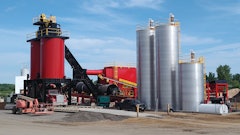
The W 210 from Wirtgen America Inc. is as much at home doing urban milling in congested San Francisco, as it is doing utility cuts for suburban gas line repairs, a San Francisco Bay Area contractor has found.
Last December, ABSL Construction, Hayward, CA, was using its two of its W 210s to undertake maintenance milling in the streets of San Francisco, and utility cuts south of the city as natural gas pipelines are upgraded in the area.
"In San Francisco we are using the W 210 to do a 2-inch grind full-width [6-feet 7-inches]," says ABSL’s Quinto Allende. "And near Stanford University, we are removing 9 inches of asphalt cold mix, basically digging out a 9-foot-wide trench for utility repair."
ABSL is a long-time user of Wirtgen cold mills. The firm currently has over 20 cold mills, and the contractor has benefited from the technological improvements the W 210 has over its predecessor, the W 2100.
"The new W 210 has a lot of computer ‘horsepower’ compared to the W 2100," Allende says. "In the event that something goes wrong, it will tell you exactly where the problem is. Their user interface is a lot simpler to use as well. In a couple of hours someone with minimal experience can be operating the equipment. It goes to show how intuitive the user interface is to pick up on."
ABSL’s W 210s have a unique fuel-saving drive concept utilizing two diesel engines, generating a total 671 hp with both engines engaged. Its CE operating weight is 62,126 lb. "The W 210 has two engines, so it has a lot more power," Allende said. "It won’t overheat and can work hour after hour with no problems."
In late 2012 the W 210 was updated by the Tier 4 interim-compliant W 210i, with very similar specifications. In addition to the dual engine design, the W 210 and W 210i have other features that enhance productivity.
Their Parallel-to-Surface (PTS) technology automatically keeps the cutter housing level as the W 210 or W 210i move into a cut, accelerating production. "Once you finish a cut, you turn off automatic, pushing one button, and the machine just lifts up out of the cut all by itself," Allende said. "It’s one less thing for the operator to think about."
Their "smart" WIDRIVE technology offers new microprocessor-controlled enhancements to machine control systems, tying all main functions to a single source to manage fuel costs, tooth costs and other variables. Their Intelligent Speed Control system incorporates an electronic flow divider that makes the four tracks work in harmony when turning a radius. Skipping and notching are eliminated, track wear is minimized, and the machine operates smoother.
They also incorporate the Level Pro system, Wirtgen’s existing automatic leveling system which is highly user-friendly, and regulates the pre-set milling depth and actual readout electronically.
"What I like about the W 210’s new grade control is that the sensors are inside the hydraulic plates, whereas in the old machines, you had a ‘yo-yo box’ string attached to the ski plate. With these machines I’m much more assured that I am matching the right grade. I still check it every 50 feet, but I’m much more confident that the machine is reading the grade right."
Asphalt and concrete milling is one of the most abrasive environments for any machine, but their new Vacuum Cutting System option will remove dust, fines and smoke from the cutter chamber and extract it out the conveyor, keeping the machine cleaner and prolonging component life.
"The VCS works well," Allende says. "There are jobs where they really want to minimize dust, such as when we work at San Francisco International Airport. They want to keep dust down for visibility but don’t want us to use a lot of water as they want to pave on the same shift. The vac system picks up a lot of that fine material and is an ideal system to use on a job like that."
And Wirtgen’s new 3DS Flexible Application Drum Speed system will automatically slow drum speeds in deep cuts, saving on fuel consumption and tooth wear. Optional forward and rear television cameras provide a view of reclaimed asphalt pavement into the haul truck hopper, or when the unit is in reverse, a view to the rear.
"As we were one of the first local contractors to do cold milling decades ago, we always looked for the best new technology," Allende says. "A few of our Wirtgen machines are almost a decade old, and we are still using them today."


























